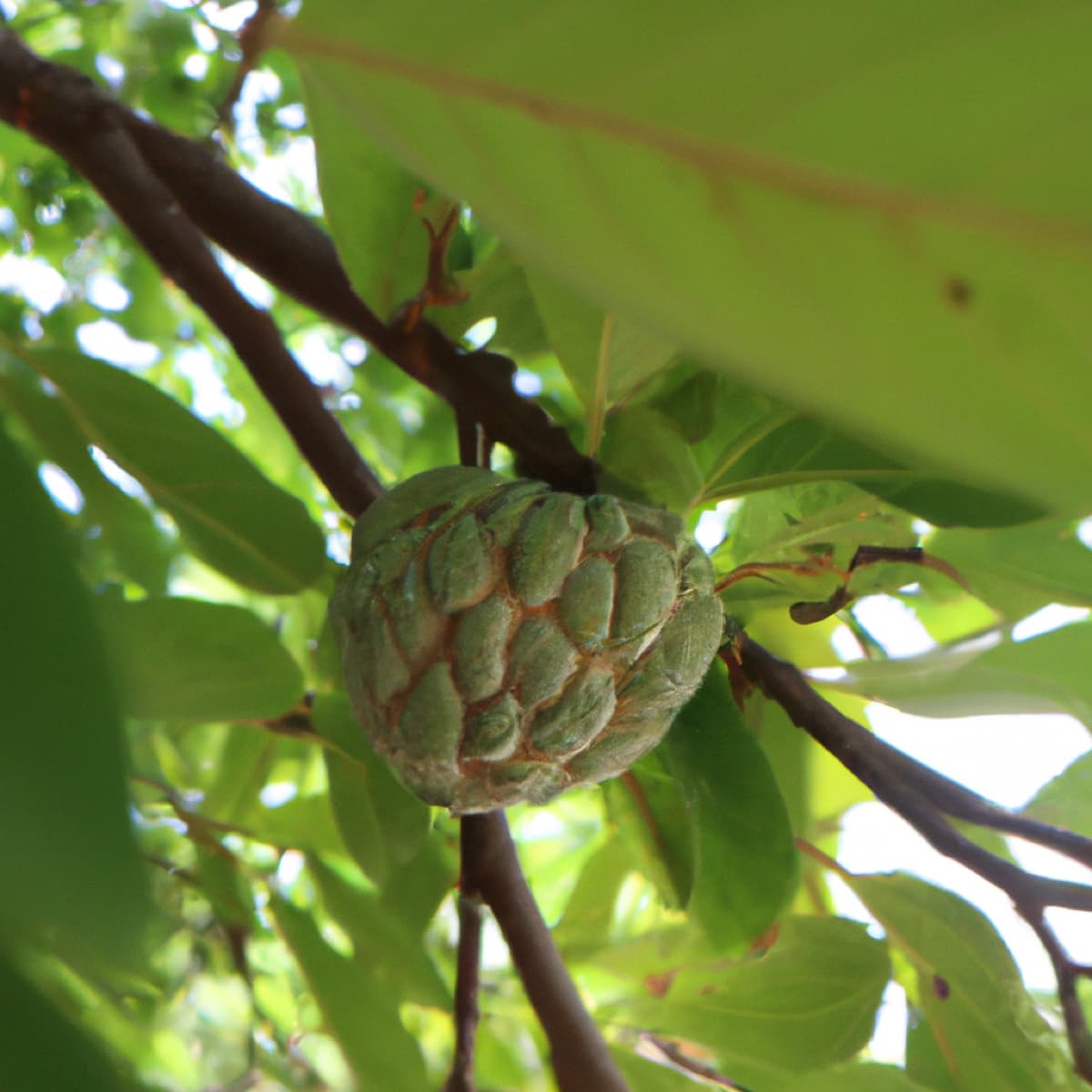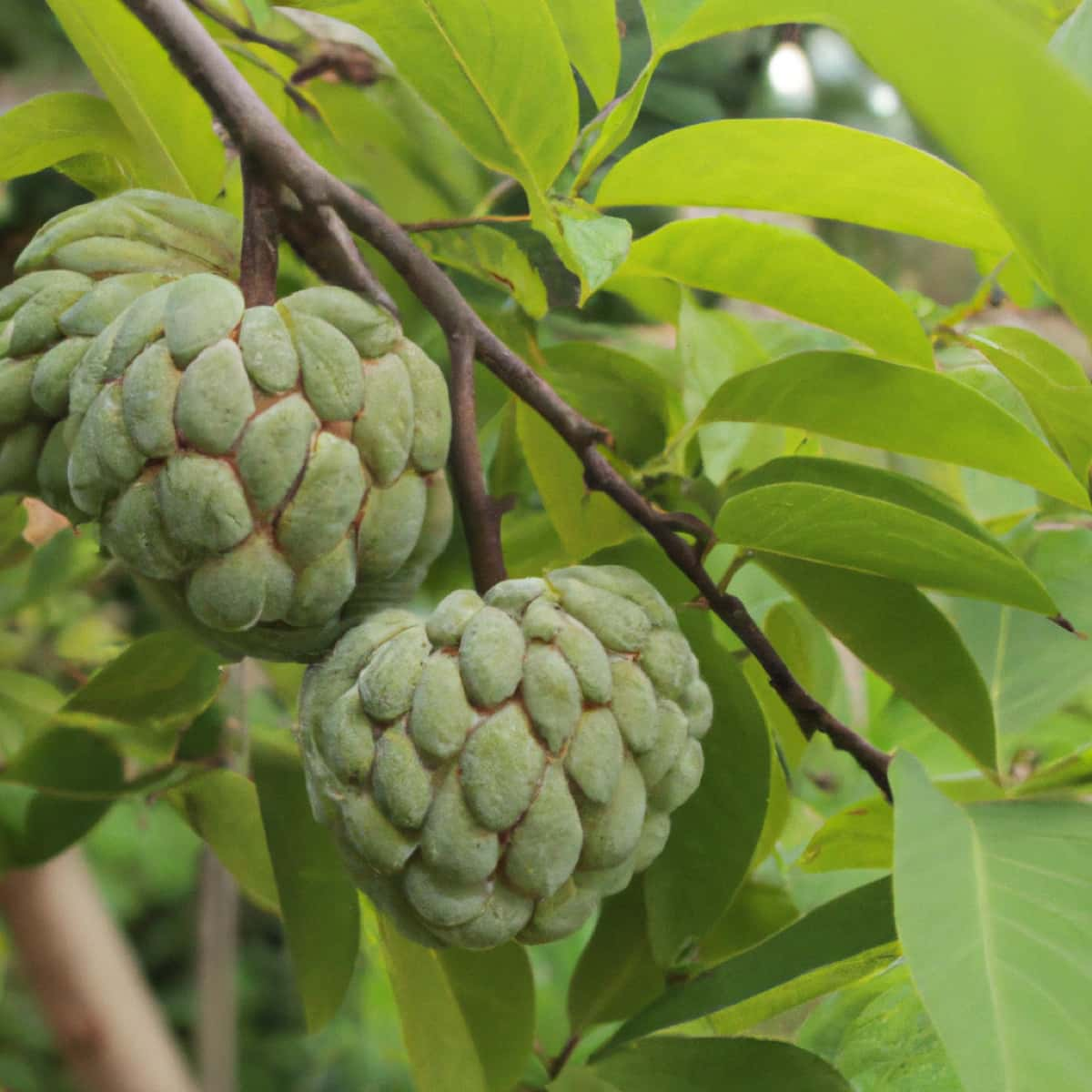The sugar apple tree, also known as custard apple, is a tropical fruit tree that produces delicious edible fruits. However, like many other trees, it is prone to disease and other causes of death. Knowing the causes of a dying sugar apple tree and how to fix it can help ensure its longevity and health.

9 Causes of Dying Custard Apple Tree
Why is My Sugar Apple Tree Dying in Summer Heat, and How Can I Save It?
The summer heat can be challenging for sugar apple trees, as they prefer cooler temperatures. When exposed to 32°C or higher temperatures, the tree leaves will wilt and become discolored. The tree may also suffer from drought stress and cannot breathe enough water to survive.
- Sugar apple trees need plenty of water to stay healthy, especially in hot weather. Water your sugar apple tree at least once a week and more often if possible. Deep watering is best, allowing the water to reach the tree’s roots.
- Provide the tree with some shade. Planting shrubs or trees can provide shade and help to protect the tree from the heat. Additionally, using a shade cloth on the tree can help to block out direct sunlight.
Preventing Sugar Apple Tree Death From Fungal Infections: Effective Remedies and Prevention Tips
Fungal infections can harm sugar apple trees, resulting in stunted growth, poor fruit production, and even death. Therefore, take the necessary steps to prevent fungal infections and provide effective remedies when they occur.
- Keep the soil around the tree’s base free of debris and moisture, and keep the tree in a well-ventilated area. Mulching and pruning can also help to reduce the risk of fungal infections.
- Use a fungicide specifically designed for sugar apple trees. Several fungicides are available, and it is important to read the instructions and apply the product correctly. Ensure all tree areas are treated, as the fungus will spread quickly and cause serious damage.
Identifying Nutrient Deficiencies in Sugar Apple Trees and Remedies to Revive Them
Sugar apple trees require adequate nitrogen, phosphorus, and potassium for healthy growth. Without one or more of these nutrients, sugar apple leaves will turn yellow or brown, stunting tree growth and reducing fruit production. A soil test will measure the soil’s nitrogen, phosphorus, and potassium levels and provide a more accurate diagnosis of the deficiency. Once the deficiency is identified, corrective measures can be taken to revive the sugar apple tree.
The most common remedy for nutrient deficiencies in sugar apple trees is fertilization. Fertilizers provide the tree with the missing nutrients it needs to grow and thrive. Fertilizers will come in many forms, including organic fertilizers such as compost, manure, or chemical fertilizers. When using chemical fertilizers, follow the directions carefully, as over-fertilizing will cause more damage than good.
How to Protect Sugar Apple Trees From Pests and Diseases to Prevent Decline and Death
To ensure the health of the sugar apple tree, it is important to take preventive measures to protect it from these pests and diseases.
- Sugar apple trees should be planted in an area that is well-drained and receives full sun. If the tree is planted in a spot that is too wet or shady, it is more likely to become susceptible to pests and diseases.
- Prune dead or damaged branches and excess foliage.
- Look for any wilting or discolored foliage, holes in the leaves, or any other signs of damage. If you notice these signs, use an insecticide to manage pests. Insecticides can be used to kill pests that cause damage to your tree. Follow the instructions on the insecticide packaging to ensure proper use.
Overwatering Issues in Sugar Apple Trees: Signs, Symptoms, and Steps to Rescue a Dying Tree
Overwatering issues in sugar apple trees can be devastating for a home garden. The signs and symptoms of overwatering can be difficult to detect, and rescuing a dying tree can be complex. Symptoms of overwatering in sugar apple trees include wilting, yellowing, dropping leaves, and stunted growth.
If your sugar apple tree is suffering from overwatering, there are a few steps you can take to rescue it. First, reduce the amount of water you are giving to the tree. Before watering, allow the soil to dry completely. If the tree is in a spot with poor drainage, consider relocating it to a better spot. If the soil is clay-based, add more organic matter to help with drainage. You can also try aerating the soil to help with water retention.
In case you missed it: How to Grow Purple Custard Apple from Seed: A Step-By-Step Planting to Harvest Guide

Underwatering Issues in Sugar Apple Trees: Signs, Symptoms, and Steps to Rescue a Dying Tree
Underwatering is a common issue with sugar apple trees. When a tree is not watered enough, it can become weak and even die. Symptoms of underwatering in sugar apple trees include leaf drop, stunted growth, and yellowing of new leaves. Fruits may be undersized and have cracked skin. The tree’s bark may become brittle, and the wood underneath the bark may be discolored.
If the soil is dried out, it may need to be soaked several times before the water is fully absorbed. The tree should be watered deeply, and the soil should be moist but not soggy. Mulch, such as wood chips, should be applied in a 2-3 inch layer around the tree. This will help to slow down evaporation and keep the soil moist.
Sugar Apple Tree Winter Damage/dying: Protecting Trees From Frost and Cold Temperatures
Winter is a difficult season for many trees, and the sugar apple tree is no exception. Cold temperatures, frost, and the occasional snowfall can damage or even kill the tree, but there are a few steps to protect your tree from winter damage.
- Ensure your sugar apple tree is planted in an area with plenty of sunlight. This will help the tree absorb more heat during the cold winter months.
- Ensure the soil is well-draining so the tree’s root system can stay healthy and not be susceptible to frost damage.
- Be sure to prune branches that are not necessary, such as dead or damaged branches, to help the tree conserve its energy.
- Burlap or frost cloth should be wrapped around your sugar apple tree if temperatures are expected to drop below freezing. This will help protect the tree from extremely cold temperatures.
Improper Pruning May Cause Sugar Apple Tree Death: Pruning Methods for Healthy Growth
Improper pruning of sugar apple trees can lead to their death. To ensure the healthy growth of a sugar apple tree, it is important to use the right pruning methods.
- Prune the tree during the dormant season, usually in the winter. Removing dead, diseased, or damaged branches immediately is important.
- Inspect the tree yearly to identify branches crossing or rubbing against each other so they can be removed.
- Pruning needs to be done in a way to maintain the natural tree’s shape. When pruning, leave the branch collar intact, as this helps to protect the tree from disease.
- Any large branches should be removed in stages, with the final cut being made just outside the branch collar.
Reviving a Stressed Sugar Apple Tree: Rehabilitation Methods for Overall Recovery
Unfortunately, sugar apple trees can be prone to stress and illness. If you notice that your sugar apple tree is looking worse, there are steps you can take to help revive it. Here are some rehabilitation methods that can be used to help your sugar apple tree return to its former glory.
- Water regularly: Sugar apple trees need lots of water, so make sure they get enough. Water your tree once a week, and if your area is prone to periods of drought, water more frequently.
- Feed the tree: Fertilizing your sugar apple tree is essential to help it recover from stress. Use a fertilizer specifically designed for fruit-bearing trees, and apply it at least once or twice a year.
- Mulch your tree: Mulching a tree helps retain moisture and keep the soil moist. This can help reduce the stress the tree is feeling, as well as prevent any potential diseases from taking hold.
- Monitor the leaves and fruit: Keeping an eye on any changes in the tree’s leaves and fruit can help you detect signs of stress or disease early. If you observe any discoloration or signs of disease, contact a professional to help you diagnose and treat the problem.
In case you missed it: How to Increase Female Flowers in Apple: Explained in 10 Steps for High Yields and Profit

Conclusion
In conclusion, a dying sugar apple tree can be caused by improper care, pests, and disease. Knowing the causes of a dying sugar apple tree and how to fix it can help ensure its health and longevity. Proper care, insecticides, fungicides, pruning, and fertilization can all help keep the tree healthy and thriving.
- Feed Your Flock for Less: Top 10 Tips to Save on Chicken Feed
- Ultimate Guide to Ossabaw Island Hog: Breeding, Raising, Diet, and Care
- Hatching Answers: The Top 10 Reasons Your Chickens Aren’t Laying Eggs
- Eggs and Economics: Breaking Down the Cost of Raising Backyard Chickens
- Defend Your Greens: Proven Methods to Keep Iguanas Out of Your Garden
- Ultimate Guide to Cinnamon Queen Chicken: A Comprehensive Guide for Beginners
- Ultimate Guide to California Tan Chicken: Breeding, Raising, Diet, Egg-Production and Care
- Ultimate Guide to Marsh Daisy Chicken: Breeding, Raising, Diet, and Care
- 10 Types of Chicken Farming Businesses You Can Start for Profits